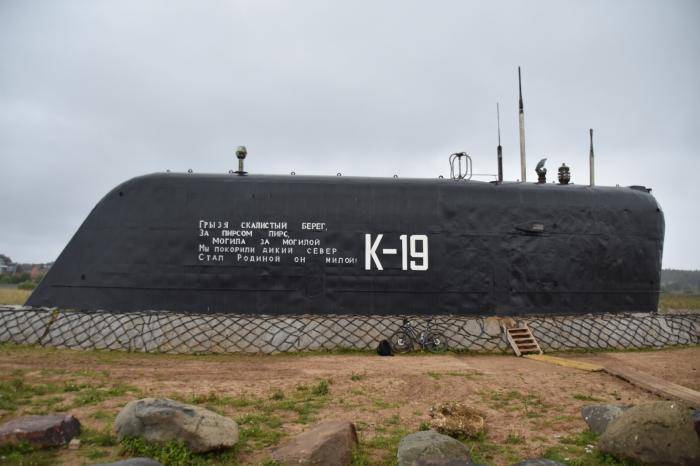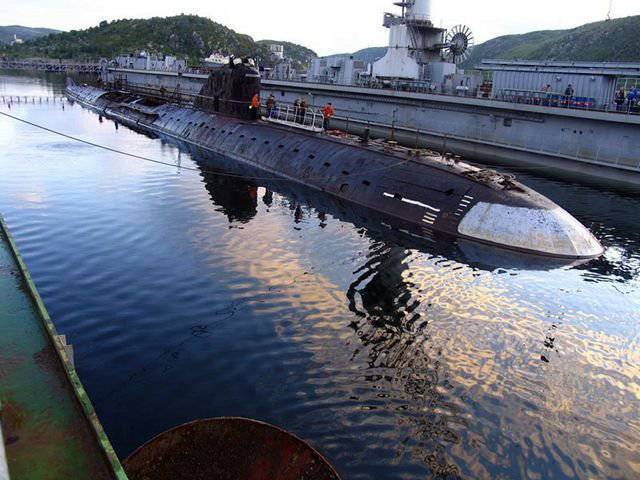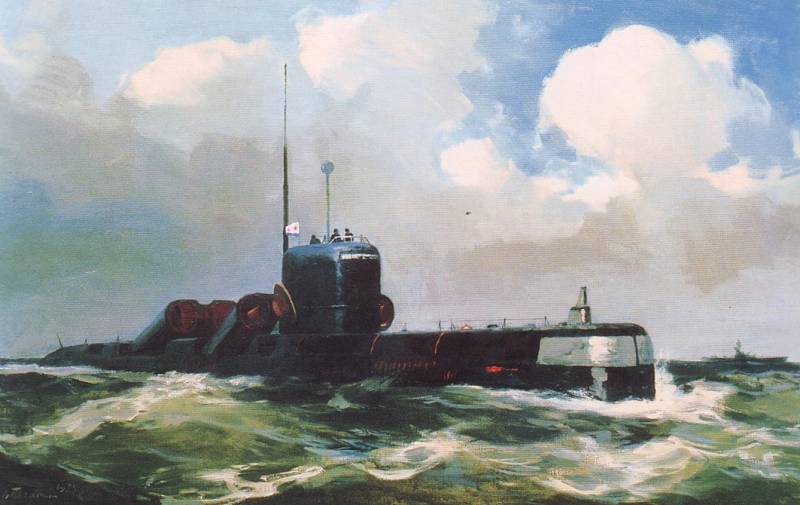Time for the first. Nuclear submarines of the USSR

Photo: Roman Abramov, wikimapia.org
On July 20, 1960, at 12:39 pm, a radiogram “POLARIS - FROM OUT OF THE DEEP TO TARGET. PERFECT ". The first launch of the "Polaris" ballistic missile was performed from a standard launch vehicle. The world entered a new era, an era in which politics and power were determined not by dreadnoughts or aircraft carriers, but by the submarine assassins of cities. The American missile carrier carried 16 Polaris, capable of covering 2200 km and delivering 600 kilotons with an accuracy of 1800 meters. By the time the Cuban Missile Crisis began, the US Navy had nine such missile carriers.
The threat was serious, especially since we lagged behind in submarine missiles, and our R-13 with a surface launch could carry a megaton charge only 600 km, but not so fatally - in addition to the Cuban missile crisis, there were 22 diesel "Golf" projects 629A, in total - 66 P-13, which, of course, is less than that of the United States, but it is quite enough to devastate the coast of the United States. Moreover, 6 Project 644 submarines carrying P-5 strategic cruise missiles and six upgraded Project 665 submarines with the same missiles should be added to them. In total - 36 strategic sea-based cruise missiles. And this, again, is not all - the first six boats of Project 651 have already been laid.
There was also a breakthrough in missiles - the R-21 missile was being finalized with an underwater launch, a range of 1400 km and a megaton charge. It is clear that diesel missile carriers are not a panacea, but the United States had to take them into account, and the likelihood of turning its coast on both oceans into a radioactive dead zone was quite real. In short, there was no need for haste, especially since studies were underway on even more powerful missiles and their carriers, in no way inferior to the George Washington and Polaris. In the meantime, for several years it was possible to engage in experiments and trial operation.
It is possible, but ... The leadership of the USSR dreamed of nuclear submarines, because here we were lagging behind. The first US nuclear submarine, USS Nautilus, entered service in 1954, followed by the USS Seawolf with a liquid metal reactor in 1957 and a series of four Skate units in 1957-1959. Our first nuclear submarine K-3 "Leninsky Komsomol" entered service only in December 1958. And immediately, without waiting for the results and without trial operation, went into series. And in parallel, again without elaboration, the missile carriers of Project 658 and SSGN of Project 659 - the first generation of Soviet nuclear submarines - went into series.

Our first-born Project 658 entered service on November 12, 1960, just a couple of months later than the American opponent, but they were completely different ships. Three R-13 missiles were incomparable with 16 Polaris, and the surface launch neutralized the advantages of a nuclear power plant - unmasking that way, that way. And most importantly, the capricious and unreliable power plant gave the informal name K-19 - Hiroshima. We are talking about the events of July 3-4, 1961, when 8 crew members died as a result of a radiation accident. The repair of the boat took two years, and the reactor compartment had to be completely changed. The remaining 659 were also not happy: K-33 - two accidents with TVEL, K-16 - gas leakage in the circuit ... And most importantly - with such difficulty and at such a price, the ships built entered combat service only in 1964, and even then - in the same period, modernization begins with their rearmament for R-21 missiles. As a result, the eight built missile carriers brought a minimum of practical use, and after 1967, when the SSBN 667A began to enter service, they instantly became hopelessly obsolete. Although they were like this before, compared to their American opponents.
Why they were built from the point of view of logic is difficult to understand - exactly the same functions with the same set of weapons were performed by diesel boats 629A. And for training and testing of technologies, torpedo nuclear submarines of project 627 were quite suitable. For example, during the Caribbean crisis, only one nuclear submarine of project 659 was manufactured for hostilities, which, against the background of 22 diesel ones, is a near-zero factor.
Even more incomprehensible story carriers "P-5" - SSGN project 659. They were built for the Pacific fleet in the amount of five pieces and as a result received a carrier of 6 missiles with the same problems - surface launch, capricious power plant, high noise and low reliability. The result was, in general, similar: K-45 - a leak in the primary circuit is already being tested, K-122 - an accident in the gas generator, K-151 - a leak in the third circuit and overexposure of the crew. And most importantly, since 1964, the boats have been put for repairs, the missile system has been dismantled, turning into torpedo ones, some deteriorated analogues of Project 627. In a word, the money has been spent, unique specialists are busy, and there is zero sense. There was nothing to study the operation of the reactor, and other ships, diesel, could also shoot the P-5. But the idea of a first-generation submarine with surface-launch heavy cruise missiles deeply sunk into the soul of the fleet leadership, otherwise it is difficult to explain the Project 6 boats, slightly altered for the P-675 anti-ship missiles, built in the amount of 29 units. If at the time of design the chances of surfacing, a 20-minute salvo and escorting missiles on the surface were still there, then already in the 70s there were no chances. The submariners, perhaps, would have had time to fire the first four-missile salvo and accompany the missiles before the target is captured by the GOS, but at the cost of their lives and the ship. There was a complete "order" with the accident rate, too, although it was easier than in earlier projects - after all, the power plant had been more or less brought up by that time.
Well, Novembers, as the Americans called them, project 627A torpedo nuclear submarines. K-5 - replacement of the reactor compartment, K-8 - steam generator leak with overexposure of sailors, K-14 - replacement of the reactor compartment, K-52 - rupture of the primary circuit, overexposure of the crew ... the number of forces and means, the second generation began to enter the system, making the first-born ships of the second grade. It is clear, they were needed, of course, this is a stage of development and testing, but why are there 14 ships for testing? It would be possible to start with experimental ones - one conventional, steam-water, and one with liquid metal fuel, then, then, based on the results of tests, build a small series for testing basing and maintenance with crew training, and only then proceed to the mass construction of the second generation. Instead, they built 56 ships of the first generation, after which we realized that we were losing the race anyway, and the basis of nuclear deterrence is still diesel missile carriers, and, finally, they began to build ships of the second generation, which by the end of the 60s ensured nuclear parity at sea. and the threat of the US AUG - after all, the inconspicuous SSGNs of project 670, which began to enter the fleet since 1967, were much more dangerous for the enemy than project 675, at least with lower noise, underwater missile launch and more advanced power plants. And it was they, nicknamed by the Americans Charlie, in contrast to ECHO 2, who could carry out a normal AUG attack.
In any case, the monuments of that era still exist: in the form of the reactor compartments of the first generation boats flooded in the Arctic, with which they are now gloomily thinking what to do - to raise or leave as is. The first is expensive and very dangerous, the second is simply dangerous, they will not be able to stand forever safely at the bottom. Do not forget about the ruined lives of people who served at that time and took huge doses of radiation. And if Khrushchev's voluntarism had not manifested itself, it would have been possible to save fate, money, and the prestige of the country, which was not influenced in the best way by regular accidents and disasters. Moreover, I repeat - there was no urgent need for the construction of 56 of these ships, and there was no urgent need either, it was quite possible to get by with a much smaller number.

Information